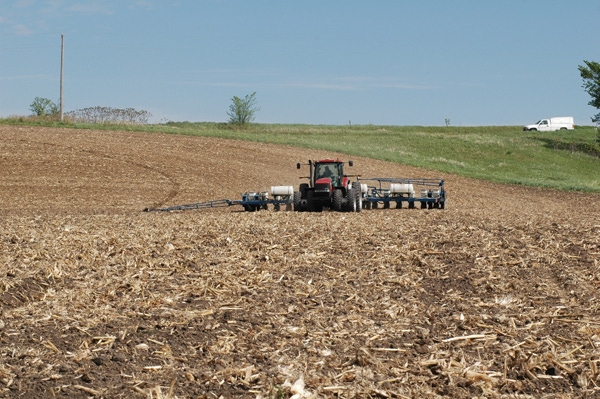April 11, 2013

Mistakes made during crop establishment are usually irreversible, and can put a ceiling on a crop's yield potential before the corn plants have even emerged. The following are some proven practices that will help get a corn crop off to a good start.
1. Perform tillage operations only when necessary and under the proper soil conditions. Avoid working wet soil and reduce secondary tillage passes. Perform secondary tillage operations only when necessary to prepare an adequate seedbed. Shallow compaction created by excessive secondary tillage can reduce crop yields. Deep tillage should only be used when a compacted zone has been identified and soil is relatively dry. Late summer and fall are the best times of year for deep tillage.
Like what you're reading? Subscribe to CSD Extra and get the latest news right to your inbox!
2. Complete planting by early May. The recommended time for planting corn in northern Ohio is April 15 to May 10 and in southern Ohio, April 10 to May 10. However if soil conditions are dry and soil temperatures are rising fast (and the five-to-seven-day forecast calls for favorable conditions), start planting before the optimum date. During the two to three weeks of optimal corn planting time, there is, on average, only one out of three days when fieldwork can occur. Avoid early planting on poorly drained soils or those prone to ponding. Yield reductions resulting from "mudding the seed in" are often much greater than those resulting from a slight planting delay. In 2011 and 2012, many Ohio growers observed that later-planted corn yielded better than early corn due to unusually favorable rainfall and temperature conditions in late July and August.
Seeding rate, depth
3. Adjust seeding depth according to soil conditions. Plant between 1½ and 2 in. deep to provide for frost protection and adequate root development. Seeding depth should be monitored regularly during the planting operation and adjusted for varying weather and soil conditions. Irregular, especially shallow, planting depths contribute to uneven plant emergence, which can reduce yields. See last week’s newsletter article for more on the importance of avoiding shallow planting depths.
4. Adjust seeding rates on a field-by-field basis. Adjust planting rates by using the yield potential of a site as a major criterion for determining the appropriate plant population. Higher seeding rates are recommended for sites with high-yield potential with high soil fertility levels and water holding capacity. OSU plant population studies conducted from 2006 to the present suggest that on highly productive soils, with long-term average yields of 190 bu./acre or more, final stands of 33,000 plants/acre or more may be required to maximize yields.
Lower seeding rates are usually preferable when droughty soils or late planting (after June 1) limit yield potential. On soils that average 120 bu./acre or less, final stands of 20,000-22,000 plants/acre are adequate for optimal yields. On soils that average about 150 bu./acre, a final stand of 30,000 plants/acre may be needed to optimize yields.
Seeding rate can be cut to lower seed costs but this approach typically costs more than it saves. Most research suggests that planting a hybrid at suboptimal seeding rates is more likely to cause yield loss than planting above recommended rates (unless lodging becomes more severe at higher population levels) and harvest delays occur. When early planting is likely to create stressful conditions for corn during emergence, e.g. no-till in corn residues in early to mid April, consider seeding rates 10-15% higher than the desired harvest population. Follow seed company recommendations to adjust plant population for specific hybrids.
Hybrids
5. Plant a mix of hybrid maturities. Planting a mix of hybrids with different maturities reduces damage from diseases and environmental stress at different growth stages (improving the odds of successful pollination) and spreads out harvest time and workload. Consider spreading hybrid maturity selections between early-, mid-and full-season hybrids. For example, a 25‑50‑25 maturity planting, with 25% in early-to mid-season, 50% in mid-to full-season and 25% in full-season. Planting a range of hybrid maturities is probably the simplest and most effective way to diversify and broaden hybrid genetic backgrounds.
6. Plant full-season hybrids first. Planting a full‑season hybrid first, then alternately planting early‑season and mid‑season hybrids, allows the grower to take full advantage of maturity ranges and gives the late‑season hybrids the benefit of maximum heat unit accumulation. Full‑season hybrids generally show greater yield reduction when planting is delayed compared with short ‑to mid‑season hybrids.
You might also like:
Is There a Yield Penalty with Continuous Corn?
You May Also Like




